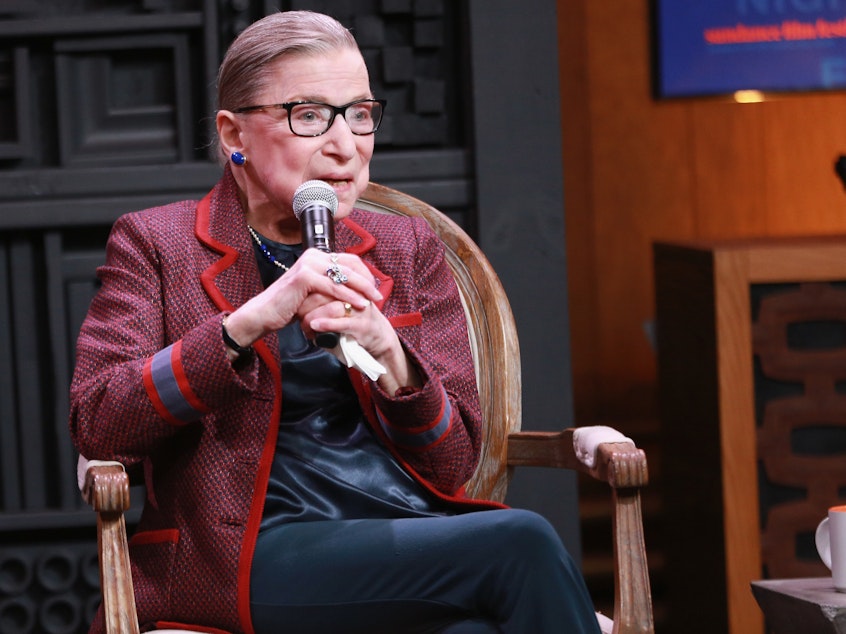'Ruth Bader Ginsburg' reminds us why the Justice is a true legal icon

Justice Ruth Bader Ginsburg has become a cultural icon, the subject of two movies in 2018 alone — and an opera and a workout book, among other things.
She is the Notorious R.B.G., emblazoned on T-shirts, made into memes, and parodied on Saturday Night Live. There's even an action figure of her.
Jane Sherron De Hart reminds us in her new scholarly biography, Ruth Bader Ginsburg: A Life, just what got the ball rolling on all of this: Ginsburg is a true-blue legal icon.
Though unauthorized, De Hart's biography draws on extensive research, including six interviews with the justice, as well as interviews with her family members, friends and colleagues.
That De Hart is a historian comes through. The book is largely linear and chronological. At each stop, De Hart provides historical detail to put Ginsburg's life in context, whether growing up as Kiki Bader in Brooklyn during the Great Depression and World War II, studying at Cornell during the McCarthy era, or working in a male-dominated profession before, during and after the women's movement — and being a central figure in that movement.
Sponsored
Ginsburg "offered a guiding hand in over sixty cases dealing with gender equality, including a dozen that reached the Supreme Court. With intellectual rigor and precision, she showed Americans that women's rights were human rights," De Hart notes. The biography goes deep into many of these cases.
In Reed v. Reed in 1971, Ginsburg's "brief won the case, convincing the [Supreme Court] justices for the first time in the nation's history that gender-based discrimination violated the equal protection clause of the Fourteenth Amendment." Reed struck down an Idaho statute that favored men as administrators of estates.
Ginsburg also took on equality cases for male plaintiffs and won. For instance, Charles Moritz, a single man who had nursing expenses from caring for his elderly mother, was denied a tax deduction that would have been available to a single woman. Ginsburg and her husband, Marty, worked on this case together and won in the U.S. Court of Appeals for the 10th Circuit.
Ginsburg did not foresee being a trailblazer for equality. As a law student, her passion was civil procedure. Ginsburg started as "The World's Greatest Living Authority on Section Umpty-ump of the Swedish Civil Practice Act in relation to Section Ump-Umpty" of the Federal Rules of Civil Procedure, according to a friend quoted in the book, referring to time she spent in Sweden, studying their system. But she developed into a "tiger" for equality, "a quiet tiger, a moderate, sensible tiger, but a fearsome tiger."
Ginsburg's personal experiences — and the time she was living in — made all the difference. Though she graduated first in her law school class, she could not find a job, initially. She was a working mother at a time when that was unique. Pay disparities and pregnancy discrimination, among other problems, were openly acknowledged.
Sponsored
The book also sheds light on other challenges Ginsburg overcame. Her father, an immigrant from Russia, lost his business and struggled financially. Her mother died just days before Ginsburg's high school graduation, after a long illness. Her only sibling died as a child. Even though she was too young to remember her sister, Ginsburg remembered her parents' grief and also understood why they were overprotective. Marty was diagnosed with cancer when the two were in law school. He survived then but died from cancer in 2010, leaving her a widow. The justice is also a cancer survivor herself.
On a lighter note, comments from friends add color and humor throughout the book.
The justice is known for her measured, unrushed style of speech, which apparently transfers to eating, as well. "World Wars, Court calendars, 'Gandhi,' [and] Davis Cup matches can be completed before [Ginsburg] will finish an appetizer." Ginsburg's secretary remembers her asking what was going on with a parade outside. When told it was because the local team won the Super Bowl, Ginsburg asked, "What's the Super Bowl?"
The justice prefers the arts, especially opera and theater, an interest she and Marty shared. When Ginsburg became a judge on the U.S. Court of Appeals for the District of Columbia Circuit, the family moved to the Watergate, right next to the Kennedy Center and its many artistic offerings.
The latter part of the book, which covers recent Supreme Court decisions on matters such as same-sex marriage and voting rights, could perhaps have been edited further. Certainly, De Hart points out Ginsburg's connection to the cases, but the descriptions don't feel as uniquely "her" as those in the rest of the book.
Sponsored
The book is lengthy, and mainly for the serious student, but it is readable and rewarding for those interested in learning about Ginsburg's groundbreaking career and remarkable life.
Michelle Olsen is an attorney who has worked in private practice and for the federal government. She has published numerous articles about the Supreme Court and federal appellate courts and maintains a popular Twitter feed on those topics (@AppellateDaily). [Copyright 2018 NPR]


